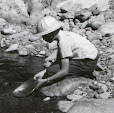With winter seemingly approaching an end, some of us may be thinking about the coming season's prospecting opportunities. One of the essential tools for exploring the back-country in search of valuable mineral deposits is a good map. For many years, the U. S. Geological Survey's 7.5' quadrangle maps have fulfilled this role. Graphically displaying landforms, elevation contours, streams, lakes, and other bodies of water, as well as roads, trails, selected buildings, and other man-made features (including mines!), these maps have proven indispensable for staying oriented and on track in the wilds.
In 2013 the USGS began phasing in a significant design change for the venerable 7.5' quadrangle map. The new design incorporates information from
The National Map databases to produce a digital quadrangle map with increased accuracy and selectable layers showing orthoimagery, transportation features, geographic names, topographic contours, boundaries, hydrography, woodland, structures, and the
United States National Grid. The
Public Land Survey System, with its townships and sections, is in the process of being added to these maps. In order to keep the maps as current as possible, the orthoimagery base layer will be updated at least every three years.
These digital maps are available online for free download as PDF files with a geospatial extension and are known as Geo-referenced PDFs (or GeoPDFs). Most map files seem to run about 20MB in size and can be opened with the free
Adobe Reader or any other PDF reader that shows layers. (For the illustrations in this article, I used the free
Nitro Reader 3 software.)
As an example, consider the GeoPDF for the Monte Cristo, Washington, quadrangle with all data layers turned on:
 |
| Click image for full size. |
On the left-hand side of the image you can see the layers menu, which allows you to control the information displayed on the map.
To better see the detail, let's look at an area on the map showing the junction of Silver Creek with the North Fork of the Skykomish River:
 |
| Click image for full size. |
The contour lines and other map features are superimposed on the orthoimagery, which gives a very good idea of terrain as well as the ground cover. While the imagery layer may give a good idea of what the countryside looks like when viewing the map on a computer, it would probably not be suitable for a printed map to be used in the field. We can create a map without the aerial image by unchecking the orthoimagery layer in the PDF. The result, reproduced below, would easily show compass bearing lines, GPS way-points, and other marks the user may wish to add while using the map outdoors:
 |
| Click image for full size. |
Although one can order paper versions of these maps from the USGS, the ones I've seen all show the orthoimagery layer. While these maps would probably make handsome display items if framed, as mentioned above they would probably not be suitable for work in the field. Add to that the fact that they cost (as of this writing) $15 each and you have another incentive to look for an alternative.
The practical alternative is to print your own maps showing only those data layers you want. The best way I know to do this on a printer that only accommodates paper up to letter size is to use the
"Tiling/Poster" setting in the printer driver menu. (Check your printer manual for how to access this feature.) With my Canon MG2200, the 'Printer Properties" menu containing this setting is accessible from the PDF viewer application. This setting divides the image into multiple parts, each of which prints on its own page. The setting usually also provides an option for printing "Cut/Paste" lines in the margins of the sections to aid in taping them together. If your printer doesn't have a "Tiling/Poster" setting and you don't have the rather expensive Adobe Acrobat application (which incorporates this feature), you may be able to find a free software application that will allow you to perform this operation. One option for Windows might be
PosterPrint. I haven't tried this software, so proceed with caution if you opt to use it.
If you are using Adobe Reader to view these maps, there is a free extension for it called the
TerraGo Toolbar which you can download and install. This toolbar allows you to perform a number of special operations with the map, such as finding coordinates, measuring lengths and areas, tracking the current position of an attached GPS unit, adding notes, lines, shapes, stamping information onto the map, etc. I haven't tried this feature yet so can only go by the descriptions of its operations provided by the USGS.
In addition to the US Topo series of maps, all USGS previously issued topographic maps are available for free download from the same source as the new maps.
The US Topo mapping program is an ongoing project with more features to be added as time goes on. Incidentally, Washington is one of the states scheduled for updating in 2014.
Below are links to resources for obtaining and using these maps:
Select and download US Topo and historical topographic maps.
Factsheet on the US Topo map series.
Quickstart Guide for using US Topo maps and historical topographic maps.
In addition to the links listed above, I have updated the link to the USGS Store in the MAPPING APPLICATIONS & ONLINE SPACIAL DATA section of
Resources for Prospectors in the right-hand sidebar to provide access to both the new US Topo and all the historical topographic maps.



